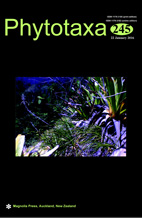Abstract
Bayesian phylogenetic analysis of nuclear ribosomal ITS and ETS confirms earlier results from chloroplast DNA phylogenetic analysis and morphology that support the recent synonymy under Dimerostemma of several species formerly recognized within the genus Angelphytum. The nine former Angelphytum species we sampled did not form a monophyletic group. Based on sampling 18 of 29 species Dimerostemma was found monophyletic and derived within Ecliptinae, although its position was not fully resolved among the accessions of 32 other genera of the subtribe. Our results add several new hypotheses of generic relationships in this group. Dimerostemma annuum, the only annual species of the genus, resolved sister to all other Dimerostemma. This with D. bishopii and D. retifolium formed a grade sister to two clades, each containing a combination of Angelphytum and Dimerostemma species. Species of Dimerostemma that have xylopodia do not form a monophyletic group. Montanoa of subtribe Montanoinae was sister to the Andean genera Idiopappus, Kingianthus and Monactis and collectively sister to a clade of Ecliptinae with seven subclades based on our sampling. The genera Kingianthus and Wedelia were not found to be monophyletic.

